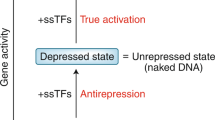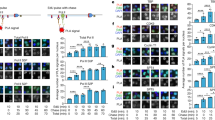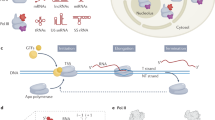Abstract
The machinery that transcribes protein-coding genes in eukaryotic cells must contend with repressive chromatin structures in order to find its target DNA sequences. Diverse arrays of proteins modify the structure of chromatin at gene promoters to help transcriptional regulatory proteins access their DNA recognition sites. The way in which disruption of chromatin structure at a promoter is transmitted through a whole gene has not been defined. Recent breakthroughs suggest that the passage of an RNA polymerase through a gene is coupled to mechanisms that propagate the breakdown of chromatin.
This is a preview of subscription content, access via your institution
Access options
Subscribe to this journal
Receive 51 print issues and online access
$199.00 per year
only $3.90 per issue
Buy this article
- Purchase on Springer Link
- Instant access to full article PDF
Prices may be subject to local taxes which are calculated during checkout



Similar content being viewed by others
References
Kornberg, R. D. & Lorch, Y. Twenty-five years of the nucleosome, fundamental particle of the eukaryotic chromosome. Cell 98, 285–294 ( 1999).
van Holde, K. E. Chromatin (Springer, New York, 1989).
Orphanides, G., Lagrange, T. & Reinberg, D. The general transcription factors of RNA polymerase II. Genes Dev. 10, 2657– 2683 (1996).
Gross, D. S. & Garrard, W. T. Nuclease hypersensitive sites in chromatin. Annu. Rev. Biochem. 57, 159 –157 (1988).
Struhl, K. Histone acetylation and transcriptional regulatory mechanisms. Genes Dev. 12, 599–606 ( 1998).
Hebbes, T. R., Clayton, A. L., Thorne, A. W. & Crane-Robinson, C. Core histone hyperacetylation co-maps with generalized DNase I sensitivity in the chicken beta-globin chromosomal domain. EMBO J. 13, 1823–1830 (1994).
Kuo, M.-H. & Allis, C. Roles of histone acetyltransferases and deacetylases in gene regulation. BioEssays 20, 615–626 (1998).
Kingston, R. E. & Narlikar, G. J. ATP-dependent remodelling and acetylation as regulators of chromatin fluidity. Genes Dev. 13, 2339–2352 (1999).
Lorch, Y., Zhang, M. & Kornberg, R. D. Histone octamer transfer by a chromatin-remodelling complex. Cell 96, 389–392 (1999).
Owen-Hughes, T. & Workman, J. L. Experimental analysis of chromatin function in transcription control. Crit. Rev. Euk. Gene Exp. 4, 403–441 (1994).
Lorch, Y., LaPointe, J. W. & Kornberg, R. D. Nucleosomes inhibit the initiation of transcription but allow chain elongation with the displacement of histones. Cell 49, 203–210 ( 1987).
Clark, D. J. & Felsenfeld, G. A nucleosome core is transferred out of the path of a transcribing polymerase. Cell 71, 11–22 (1992).
Studitsky, V. M., Clark, D. J. & Felsenfeld, G. A histone octamer can step around a transcribing polymerase without leaving the template. Cell 76, 371 –382 (1994).
Studitsky, V. M., Clark, D. J. & Felsenfeld, G. Overcoming a nucleosomal barrier to transcription. Cell 83, 19–27 ( 1995).
Nacheva, G. A. et al. Change in the pattern of histone binding to DNA upon transcriptional activation. Cell 58, 27– 36 (1989).
O'Neill, T. E., Roberge, M. & Bradbury, E. M. Nucleosome arrays inhibit both initiation and elongation of transcripts by bacteriophage T7 RNA polymerase. J. Mol. Biol. 223, 67–78 ( 1992).
Studitsky, V. M., Kassavetis, G. A., Geiduschek, E. P. & Felsenfeld, G. Mechanism of transcription through the nucleosome by eukaryotic RNA polymerase. Science 278, 1960–1963 (1997).
Izban, M. G. & Luse, D. S. Transcription on nucleosomal templates by RNA polymerase II in vitro: inhibition of elongation with enhancement of sequence-specific pausing. Genes Dev. 5, 683–696 (1991).
Orphanides, G., LeRoy, G., Chang, C. -H., Luse, D. S. & Reinberg, D. FACT, a factor that facilitates transcript elongation through nucleosomes. Cell 92, 105– 116 (1998).
Izban, M. J. & Luse, D. S. Factor-stimulated RNA polymerase II transcribes at physiological elongation rates on naked DNA but very poorly on chromatin templates. J. Biol. Chem. 267, 13647–13655 (1992).
Brown, S. A., Imbalzano, A. N. & Kingston, R. E. Activator-dependent regulation of transcriptional pausing on nucleosomal templates. Genes Dev. 10, 1479–1490 (1996).
Bustin, M. & Reeves, R. High-mobility-group chromosomal proteins: architectural components that facilitate chromatin function. Prog. Nucleic Acid Res. Mol. Biol. 54, 35– 100 (1996).
Ding, H. F., Rimsky, S., Batson, S. C., Bustin, M. & Hansen, U. Stimulation of RNA polymerase II elongation by chromosomal protein HMG-14. Science 265 , 796–799 (1994).
Rowley, A., Singer, R. A. & Johnston, G. C. CDC68, a yeast gene that affects regulation of cell proliferation and transcription, encodes a protein with a highly acidic carboxyl terminus. Mol. Cell. Biol. 11, 5718– 5726 (1991).
Malone, E. A., Clarke, C. D., Chiang, A. & Winston, F. Mutations in SPT16/CDC68 suppress cis- and trans-acting mutations that affect promoter function in Saccharomyces cerevisiae. Mol. Cell. Biol. 11, 5710–5717 (1991).
Orphanides, G., Wu, W. H., Lane, W. S., Hampsey, M. & Reinberg, D. The chromatin-specific transcription elongation factor FACT comprises human SPT16 and SSRP1 proteins. Nature 400, 284–288 (1999).
Santisteban, M. S., Arents, G., Moudrianakis, E. N. & Smith, M. M. Histone octamer function in vivo: mutations in the dimer-tetramer interfaces disrupt both gene activation and repression. EMBO J. 16, 2493–2506 (1997).
Baer, B. W. & Rhodes, D. Eukaryotic RNA polymerase II binds to nucleosome cores from transcribed genes. Nature 301, 482–488 (1983).
Hartzog, G. A., Wada, T., Handa, H. & Winston, F. Evidence that Spt4, Spt5, and Spt6 control transcription elongation by RNA polymerase II in Saccharomyces cerevisiae. Genes Dev. 12, 357–369 (1998).
Winston, F. & Carlson, M. Yeast SNF/SWI transcriptional activators and the SPT/SIN chromatin connection. Trends Genet. 8, 387–391 (1992).
Wada, T. et al. DSIF, a novel transcription elongation factor that regulates RNA polymerase II processivity, is composed of human Spt4 and Spt5 homologs. Genes Dev. 12, 343–356 (1998).
Bortvin, A. & Winston, F. Evidence that Spt6p controls chromatin structure by a direct interaction with histones. Science 272, 1473–1476 (1996).
Travers, A. Chromatin modification by DNA tracking. Proc. Natl Acad. Sci. USA 96, 13634–13637 ( 1999).
Yang, X. J., Ogryzko, V. V., Nishikawa, J., Howard, B. H. & Nakatani, Y. A p300/CBP-associated factor that competes with the adenoviral oncoprotein E1A. Nature 382, 319–324 (1996).
Cho, H. et al. A human RNA polymerase II complex containing factors that modify chromatin structure. Mol. Cell. Biol. 18, 5355–5363 (1998).
Otero, G. et al. Elongator, a multisubunit component of a novel RNA polymerase II holoenzyme for transcriptional elongation. Mol. Cell 3, 109–118 (1999).
Wittschieben, B. O. et al. A novel histone acetyltransferase is an integral subunit of elongating RNA polymerase II holoenzyme. Mol. Cell 4, 123–128 (1999).
Strahl, B. D. & Allis, C. D. The language of covalent histone modifications. Nature 403, 41– 45 (2000).
Walia, H., Chen, H. Y., Sun, J. M., Holth, L. T. & Davie, J. R. Histone acetylation is required to maintain the unfolded nucleosome structure associated with transcribing DNA. J. Biol. Chem. 273, 14516–14522 ( 1998).
O'Brien, T. & Lis, J. T. Rapid changes in Drosophila transcription after an instantaneous heat shock. Mol. Cell. Biol. 13, 3456–3463 (1993).
Lee, D. & Lis, J. T. Transcriptional activation independent of TFIIH kinase and the RNA polymerase II mediator in vivo. Nature 393, 389–392 ( 1998).
McNeil, J. B., Agah, H. & Bentley, D. Activated transcription independent of the RNA polymerase II holoenzyme in budding yeast. Genes Dev. 12, 2510–2521 (1998).
Fraser, P. & Grosveld, F. Locus control regions, chromatin activation and transcription. Curr. Opin. Cell Biol. 10, 361–365 (1998).
Ashe, H. L., Monks, J., Wijgerde, M., Fraser, P. & Proudfoot, N. J. Intergenic transcription and transinduction of the human β-globin locus. Genes Dev. 11, 2494–2509 (1997).
Gribnau, J., Diderich, K., Pruzina, S., Calzolari, R. & Fraser, P. Intergenic transcription and developmental remodelling of chromatin subdomains in the human β-globin locus. Mol. Cell 5, 377–386 (2000).
Bender, M. A., Bulger, M., Close, J. & Groudine, M. β-globin switching and DNase I sensitivity of the endogenous β-globin locus in mice do not require the locus control region. Mol. Cell 5, 387–393 (2000).
Kuo, M. -H., Zhou, J., Jambeck, P., Churchill, M. E. A. & Allis, C. D. Histone acetyltransferase activity of yeast Gcn5p is required for activation of target genes in vivo. Genes Dev. 12, 627–639 ( 1998).
Felsenfeld, G., Boyes, J., Chung, J., Clark, D. & Studitsky, V. Chromatin structure and gene expression. Proc. Natl Acad. Sci. USA 93, 9384– 9388 (1996).
Roeder, R. G. The role of the general initiation factors in transcription by RNA polymerase II. Trends Biochem. Sci. 21, 327– 335 (1996).
Uptain, S. M., Kane, C. M. & Chamberlin, M. J. Basic mechanisms of transcript elongation and its regulation. Annu. Rev. Biochem. 66, 117– 172 (1997).
Neugebauer, K. M. & Roth, M. B. Transcription units as RNA processing units. Genes Dev. 11, 3279–3285 (1997).
Koleske, A. J. & Young, R. A. The RNA polymerase II holoenzyme and its implications for gene regulation. Trends Biochem. Sci. 20, 113–116 (1995).
Acknowledgements
We thank M. Hampsey, D. Luse and S. Hahn for helpful comments, and R. Sternglanz, J. Workman and S. Hahn for communication of unpublished results. Work in D.R.'s laboratory is supported by grants from the NIH and the Howard Hughes Medical Institute.
Author information
Authors and Affiliations
Corresponding author
Rights and permissions
About this article
Cite this article
Orphanides, G., Reinberg, D. RNA polymerase II elongation through chromatin. Nature 407, 471–476 (2000). https://doi.org/10.1038/35035000
Issue Date:
DOI: https://doi.org/10.1038/35035000
This article is cited by
-
Expression and chromatin structures of cellulolytic enzyme gene regulated by heterochromatin protein 1
Biotechnology for Biofuels (2016)
-
Nuclear calcium signalling in the regulation of brain function
Nature Reviews Neuroscience (2013)
-
Defects in RNA quality control factors reveal RNAi-independent nucleation of heterochromatin
Nature Structural & Molecular Biology (2011)
-
Stable transmission of reversible modifications: maintenance of epigenetic information through the cell cycle
Cellular and Molecular Life Sciences (2011)
-
Synergistic action of RNA polymerases in overcoming the nucleosomal barrier
Nature Structural & Molecular Biology (2010)
Comments
By submitting a comment you agree to abide by our Terms and Community Guidelines. If you find something abusive or that does not comply with our terms or guidelines please flag it as inappropriate.



